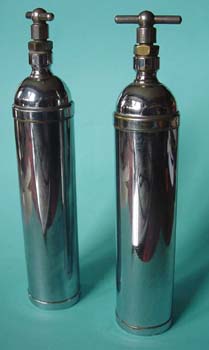 |
|
Druckflaschen n. Dr. BENGUE
|
In 1895 a dentist noticed that not infrequently his patients fell asleep when he splashed chloroethyl (= chloroethane, chloraether) on their gums in order to locally stun them by icing. This narcotic effect was confirmed in many hospitals (Hildesheim, Zurich, Basel and Constance); The quick onset and fleeting sleep caused by chloroethyl was very well suited for brief interventions, especially since the odor of the preparation was much more pleasant than that of chloroform; Pulse and breathing were unaffected, the respiratory tract was not irritated, there was no excitation phase ...
How widespread the "Chloréthyle BENGUE" was, is proved by the following anecdote. A doctor reports on taking over a practice in SchwarzAfrika: "mon prédécesseur, à l'évidence oligopharmaque et paucithérapeute, ne disposait en tout et pour tout que de Baume Baissade et de Chloréthyle Bengué"
perso.orange.fr/jdtr/Painciel.htm
The Luxembourgish legislation knew in 1959 the general anesthetic with chloroethyl:
L'anesthésie locale au chloréthyle, les anesthésies par instillations, tamponnements et badigeonnages sont includes dans le prix de l'intervention.
13 ° Anesthésie générale:
1) de courte durée au chloréthyle ou à l'évipan, in parallel with the intervention in surgical and dental surgery
2) de durée prolongée à l'éther, au chloroforme, l'anesthésie continue par voie intraveineuse ou rectale, l'anesthésie combinée avec la curarisation, l'administration de ganglioplégiques, l'hibernation contrôlée artificielle "(Memorial n ° 31 of 2.7 .1959).
In this indication, the chloroethyl is due to the difficult Dosierbarkeit u. The dangerously small anesthesia range is no longer used today, but it is for local icing.
After Dr. BENGUE is a chloraethyl bottle, which was exhibited at the Palais des Congrès in September 1999 as part of an exhibition entitled "Matériel ancien d'Anesthésie et de Réanimation".
The Parisian pharmacist Jules BENGUE (1840-1898) had developed a locally cooling ointment in the late 19th century against muscle strains consisting of menthol, salicylate and lanolin, the "Ben-Gay" - a hit in the US market.
|




